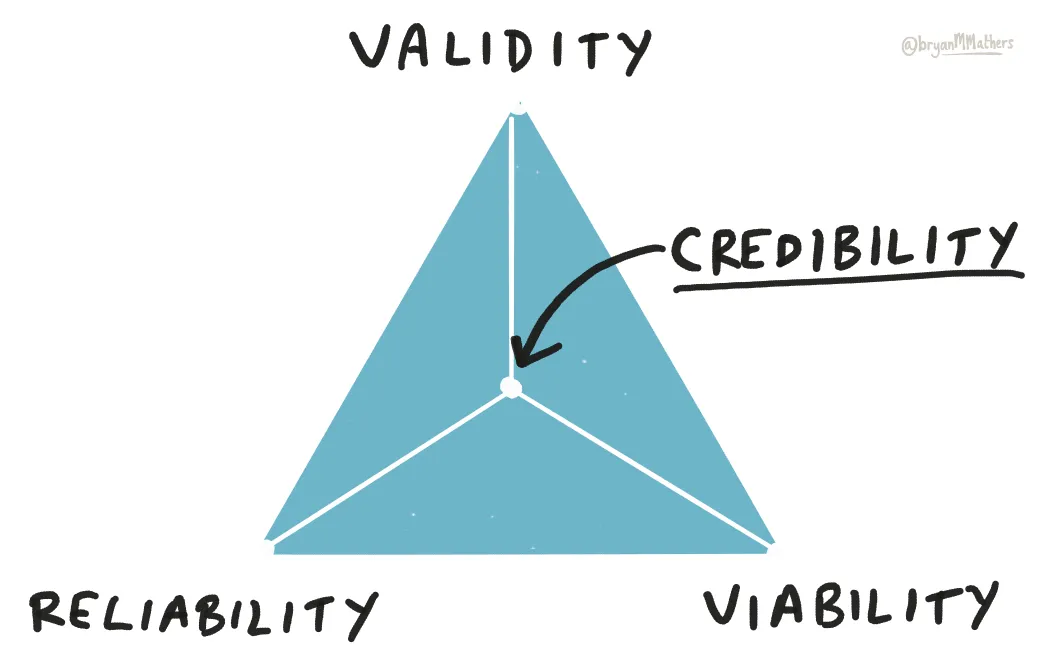Building Credibility into Digital Credentials
Digital credentials are playing an increasingly important role in recognising a broad spectrum of skills in the workplace. These range from the tangible to the abstract and innovative, but in all cases, we want credentials that are credible — that is to say, something worth earning.
In this post, we explore two distinct scenarios, a culinary school and a large organisation looking to recognise and encourage the creativity of its exmployers. In each, the core elements of validity, reliability, and viability are discussed in terms of developing a credible digital credential system .
Validity
Validity ensures that an assessment accurately measures what it claims to measure. In the context of digital credentials, this means that the assessment process leading to the badge should accurately evaluate the abilities, knowledge, or competencies it is intended to certify. This alignment between the assessment criteria and the attributes it assesses is important. Without strong validity, the integrity of the credential could be questioned, undermining its acceptance by educational institutions and employers.
Culinary School: Issuing badges for skills like knife handling, pastry making, and creative presentation means assessing specific competencies. Each badge must represent true mastery of these skills. Assessments might involve practical tests where students must produce a dish that adheres to professional standards. These practical assessments must be designed to measure relevant culinary skills accurately, ensuring the badge directly reflects the student’s capability.
Creative Organisation: For certifying creativity, the assessments might require participants to propose innovative solutions to real business challenges. These should be evaluated for their originality, practicality, and impact, ensuring the badge reflects genuine creative thinking and problem-solving ability.
Reliability
Reliability focuses on the consistency and dependability of the assessment results. A reliable digital credential system ensures that all recipients are evaluated using the same standards, and that these standards are consistently applied. This consistency builds trust in the credentialing system, making the credentials more likely to be recognised across different sectors.
Culinary School: It is crucial that all culinary tests are graded on a consistent rubric. If two students deliver dishes of similar quality, they should both earn the badge. This uniformity builds trust in the credentialing system by affirming its fairness and rigour.
Creative Organisation: When evaluating creative projects, it’s essential that all judges use the same criteria to assess the submissions. This ensures that every employee who meets the standard of creativity receives recognition, maintaining the reliability of the credential across the organisation.
Viability
Viability deals with the practical aspects of sustaining an assessment system. This includes considerations such as the costs involved, the resources required, and the technology necessary to issue and maintain the credentials. A viable digital credential system is scalable and sustainable, capable of adapting to growing demands and evolving educational environments.
Culinary School: The school needs a system that can efficiently handle various forms of assessments, from practical cooking exams to theoretical tests. This includes logistical aspects such as scheduling, recording results, and managing digital badges. The technology used must support these activities without prohibitive costs.
Creative Organisation: For a badges relating to creativity, the system should support diverse submission formats and robust communication for feedback. It must also be scalable and adaptable to accommodate a growing number of participants as the organization evolves.
Credibility as convergence
In both examples, credibility arises from the effective integration of validity, reliability, and viability. A credible digital credential system not only accurately and consistently evaluates and represents diverse skills — from cooking to creativity — but also operates efficiently and sustainably within its intended scope. This credibility enhances the value of a digital credential, making it a recognized and sought-after mark of achievement.
Next steps
Understanding and applying the principles of validity, reliability, and viability can enhance the effectiveness and perception of digital credentialing systems. Whether in a culinary school or a large corporation, these principles ensure that credentials issued represent genuine skills and achievements, fostering trust and respect in the digital badges awarded. Through these dual examples, this post demonstrates how these principles can be applied across various disciplines, encouraging readers to think broadly about the potential of digital credentials in their own fields.
Need help thinking about digital credentials in your organisation? Get in touch!
